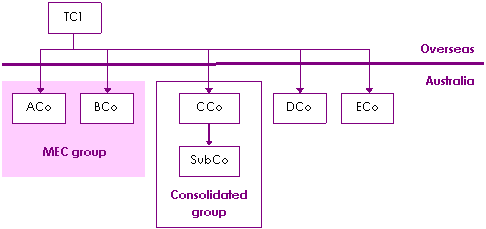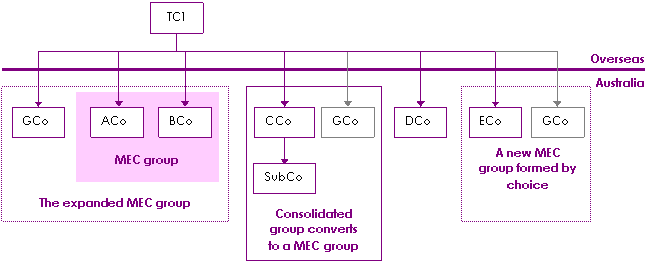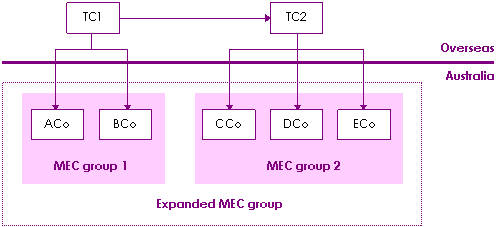Consolidation Reference Manual
You can still refer to the Consolidation reference manual for consolidation information that has not been impacted by changes in the legislation.
C10 MEC groups
C10-2 Worked example
Formation and conversion
C10-2-110 Choice on formation, special conversion events and acquisition of new eligible tier-1 companies
Description
This example shows what happens when:
- •
- a top company with existing consolidated, multiple entry consolidated (MEC) groups and unconsolidated eligible tier-1 companies acquires a new eligible tier-1 company
- •
- two or more companies become eligible tier-1 companies of the top company of both a consolidated and a MEC group
- •
- the top company of a MEC group acquires another consolidated MEC group
- •
- there is a special conversion event - the top company of a MEC group which is also the top company of a consolidated group, acquires a consolidated or MEC group, and
- •
- only some of the eligible tier-1 companies of a MEC group with a different top company join a consolidated or a MEC group.
Commentary
A MEC group can be formed in one of two ways:
- 1
- when two or more eligible tier-1 companies of a top company make the choice to form a MEC group, or
- 2
- when a MEC group is created from a consolidated group. This is known as a special conversion event.
Once a decision is made by two or more eligible tier-1 companies to consolidate, the options for any remaining eligible tier-1 companies are to:
- •
- form another MEC group
- •
- form one or more consolidated groups, or
- •
- remain outside consolidation.
There are additional rules that apply to any new eligible tier-1 companies.
Examples
Assume that TC1 is the top company and ACo, BCo, CCo, DCo and ECo are eligible tier-1 companies, that is, they satisfy the residency and ownership requirements to consolidate.
Formation of a MEC group
Figure 1: Consolidation options of eligible tier-1 companies

Initially, all the eligible tier-1 companies have several ways to choose to consolidate:
- •
- Any two or more eligible tier-1 companies can choose to form a MEC group. Example: ACo and BCo.
- •
- Each eligible tier-1 company together with a wholly-owned subsidiary can form a consolidated group with itself as the head company. Example: CCo and SubCo.
- •
- Any eligible tier-1 company can choose not to consolidate. Example: DCo or ECo.
Once two or more eligible tier-1 companies form a MEC group or an eligible tier-1 company and its subsidiary or subsidiaries form a consolidated group, the remaining eligible tier-1 companies of the group cannot choose to join either of those particular groups. For example: DCo and ECo cannot choose to join either the MEC group or the consolidated group. While any eligible tier-1 companies remain outside consolidation, they are also prevented from becoming members of the MEC group as eligible tier-1 companies when it expands (example C). Nor can they become members of the MEC group as eligible tier-1 companies when a MEC group is created from the consolidated group (example D).
After the formation of a MEC group
(A) A top company with existing consolidated groups, MEC groups and unconsolidated eligible tier-1 companies acquires a new eligible tier-1 company
Figure 2: GCo becomes eligible tier-1 company after group formation

Assume GCo becomes an eligible tier-1 company of the top company. This could occur through an acquisition of GCo by TC1.
When another company becomes a new eligible tier-1 company of the top company, some of the possibilities are:
- •
- The provisional head company of the MEC group consisting of ACo and BCo can choose to make GCo a new eligible tier-1 company of that MEC group - that is, the MEC group expands.
- •
- The head company of the consolidated group can choose to have the new eligible tier-1 company join as a member, thereby creating a MEC group from the consolidated group - that is, a special conversion event.
- •
- Either at the joining time of GCo or later, any two or all of DCo, ECo and GCo can choose to form a separate MEC group.
- •
- Either at the joining time of GCo or later, any one of DCo, ECo or GCo can choose to form a consolidated group - provided they have at least one qualifying subsidiary.
- •
- The new eligible tier-1 company, GCo, can remain outside consolidation, similar to DCo and ECo in Figure 1.
(B) When two or more companies become eligible tier-1 companies of the top company of both a consolidated group and a MEC group
When two or more companies become eligible tier-1 companies of the top company, some of the possibilities are:
- •
- The provisional head company of the MEC group (see Figure 1) can choose to expand to include any one or more of the new eligible tier-1 companies.
- •
- The head company CCo, by including any one or more of the new eligible tier-1 companies, can create a MEC group from the consolidated group - a special conversion event.
- •
- Some of the new eligible tier-1 companies can be in the expanded MEC group and the others in the MEC group formed by special conversion.
- •
- Either at joining or later, any two or more of DCo, ECo and the acquired eligible tier-1 companies can choose to form a separate MEC group.
- •
- Either at joining time or later, any one of DCo, ECo or the acquired eligible tier-1 companies can choose to form a consolidated group - provided they have at least one qualifying subsidiary.
- •
- All of the new eligible tier-1 companies can remain outside consolidation.
Note that if the new eligible tier-1 companies are members of a MEC group, and the MEC group is acquired as a whole, the provisional head company of the acquiring MEC group or the head company of the acquiring consolidated group must include all the eligible tier-1 companies of the acquired group in the expanded MEC group or the MEC group created from the consolidated group (a special conversion event).
When a special conversion event happens, the head company of the consolidated group becomes the provisional head company of the new MEC group.
(C) When the top company of a MEC group acquires another consolidated or MEC group
Assume that initially MEC group 1 and MEC group 2 are separately formed groups and subsequently TC1 acquires TC2.
Figure 3: Top company acquires other top company

When TC1 acquires TC2, the choices are either:
- •
- MEC group 1 and MEC group 2 can remain independently consolidated with respect to each other, or
- •
- the provisional head company of MEC group 1, ACo, can choose to expand to include the eligible tier-1 companies in MEC group 2 to become members of MEC group 1. All the eligible tier-1 companies in MEC group 2 must be included. The expanded MEC group will consist of ACo, BCo, CCo, DCo and ECo.
MEC group 2 ceases to exist from the time its members become members of MEC group 1. The provisional head company of MEC group 1, ACo, will be the provisional head company of the expanded MEC group.
(D) Special conversion event - when a MEC group's top company that is also the top company of a consolidated group acquires a consolidated or MEC group
Assume MEC group 1 and MEC group 2 are separately formed groups and TC1 acquires TC2. CCo is the head company of a consolidated group and an eligible tier-1 company of TC1 (
Figure 4: Special conversion event

When TC1 acquires TC2, the choices are:
- •
- MEC group 1 and MEC group 2 can merge as explained in example (C).
- •
- MEC group 1 and MEC group 2 can remain as two separate MEC groups.
- •
- CCo, as the head company of the consolidated group, can choose to make all of the eligible tier-1 companies of MEC group 2 its members and create a MEC group. This is known as a special conversion event. CCo will become the provisional head company of the new MEC group. Again, CCo must include all the eligible tier-1 companies of MEC group 2 as members.
(E) When only some of the eligible tier-1 companies of a MEC group with a different top company join a consolidated or a MEC group
In example D above, if instead of acquiring membership interests in TC2, TC1 were to acquire all the membership interests in DCo and ECo but not in GCo, it will be treated like the acquisition of two eligible tier-1 companies by TC1 (see example B). This is because DCo and ECo cease to be members of MEC group 2 as soon as they cease to be wholly-owned subsidiaries of TC2.
Note: GCo should nominate itself as the new provisional head company of MEC group 2.
Some of the options available to the group owned by TC1 on the acquisition of DCo and ECo are:
- •
- The provisional head company of MEC group 1 can choose to expand its group by including DCo or ECo or both in its group.
- •
- A MEC group can be created from the consolidated group by CCo, the head company of the consolidated group, including DCo or ECo or both in its group.
- •
- In a combination of these first two options, one of DCo or ECo could join MEC group 1 as a new eligible tier-1 company, and the other could join CCo's consolidated group, creating a MEC group.
- •
- DCo and ECo can form a new MEC group by making a choice to do so.
- •
- DCo and ECo can remain outside consolidation (since neither of them has a wholly-owned subsidiary, they are unable to form their own consolidated group with themselves as the head company).
References
Income Tax Assessment Act 1997 , sections 719-5, 719-40 and 719-50; as amended by New Business Tax System (Consolidation) Act (No. 1) 2002 (No. 68 of 2002), Schedule 1
Explanatory Memorandum to the New Business Tax System (Consolidation) Bill (No. 1) 2002, Chapter 4
Income Tax Assessment Act 1997; as amended by New Business Tax System (Consolidation and Other Measures) Act (No. 1) 2002 (No. 117 of 2002), Schedule 8
Income Tax Assessment Act 1997 , Subdivision 719-BA; as inserted by Tax Laws Amendment (2010 Measures No. 1) Act 2010 (No. 56 of 2010), Schedule 5, Part 2
Explanatory Memorandum to the Tax Laws Amendment (2010 Measures No. 1) Bill 2010, Chapter 5, paragraphs 5.65 - 5.100 and 5.105 - 5.108
History
Revision history
Section C10-2-110 first published (excluding drafts) 2 December 2002 and updated 28 May 2003
Further revisions are described below.
| Date | Amendment | Reason |
|---|---|---|
| 26.10.05 | Extensive changes throughout. | For clarification. |
| 6.5.11 | Revisions to reflect changes to the cost setting rules when groups convert. | Legislative amendments. |
Current at 6 May 2011
